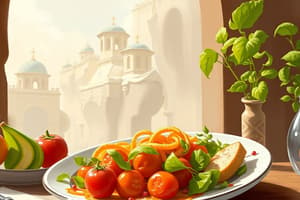Podcast
Questions and Answers
What does 'a la carte' mean?
What does 'a la carte' mean?
A menu having individual dishes with separate prices from which the guest can choose.
What does 'al dente' refer to in cooking?
What does 'al dente' refer to in cooking?
'To the tooth' - food such as pasta or vegetables, cooked until tender but still with a bite.
What is a characteristic of dishes described as 'a la mode'?
What is a characteristic of dishes described as 'a la mode'?
- Traditionally served cold
- Braises chicken
- Served with ice cream (correct)
- Prepared with excessive sauce
What does 'amuse gueule' mean?
What does 'amuse gueule' mean?
What is 'antipasto'?
What is 'antipasto'?
What does 'barding' involve in cooking?
What does 'barding' involve in cooking?
What is a 'bisque'?
What is a 'bisque'?
What is 'bouillabaisse'?
What is 'bouillabaisse'?
What does 'clarifying' involve?
What does 'clarifying' involve?
What is 'coulis'?
What is 'coulis'?
Study Notes
Classical Cuisine Terminologies
- À la carte: Menu structure allowing guests to choose individual dishes with separate prices.
- Al dente: Pasta or vegetables cooked until tender yet firm to the bite, not completely soft.
- À la mode:
- Dessert served with ice cream.
- Braised beef including veal shank julienne and vegetables.
- Dishes that are local specialties of specific regions (e.g., Tripe à la mode de Caen).
- Alsacienne: Refers to dishes from Alsace, France, often featuring sauerkraut or goose liver.
- Amuse gueule: Small bite-sized morsel served as a prelude to the first course (also known as amuse bouche).
- Antipasto: Italian term for appetizers, with the plural being antipasti.
- Argenteuil/Arshontoy: City near Paris known for asparagus, also associated with vegetable soups.
- Barding: Technique of covering game birds or small poultry with thin pork fat to retain moisture while cooking.
- Basting: Applying liquid over food being roasted or grilled to enhance flavor and moisture.
- Batter: Mixture typically composed of flour with liquids like water or milk; usually includes eggs.
- Béchamel sauce: White sauce made from roux and milk named after a court marshal of Louis XIV.
- Beurre blanc: A sauce made from butter, white wine, vinegar, and shallots.
- Beurre manié: Thickening agent made from equal parts of uncooked butter and flour.
- Beurre noir: Butter that has been cooked until a deep brown color is achieved.
- Binding: Process of thickening dishes using various agents.
- Biscuit: Refers to sponge cake.
- Bisque: Creamy soup made from pureed crustaceans or vegetables.
- Blanquette: Creamy white stew made with white meat cooked in white stock.
- Blind baking: Cooking a pastry shell partially or fully without any filling.
- Blinnis: Mini yeast-raised wheat pancakes, often served with caviar.
- Bordelaise style: Red wine sauce refined with bone marrow, named after the Bordeaux wine region.
- Bouillabaisse: Traditional French fish and shellfish soup with saffron, typically served as a main course.
- Bouquet garni: Bundle of herbs and vegetables tied together, used for flavoring.
- Brine: Solution of salt and water, often seasoned with spices and sometimes sugar.
- Cake: Food made by combining various ingredients with a sponge cake base.
- Canapé: Small hors d'oeuvre made from bread or toast topped with various ingredients.
- Caramel: Sugar cooked until golden brown.
- Carcass: Refers to the whole slaughtered animal after butchering.
- Casing: Synthetic or natural membrane (often pig or sheep intestines) used for sausages.
- Cassoulet: Hearty stew made of beans and assorted meats, often associated with French cuisine.
- Charcuterie: Term for the preparation of cured pork and various meat products, including sausages and pates.
- Chateaubriand: Double-cut beef fillet from the head of the fillet, typically grilled.
- Clam chowder: Classic New England soup made with clams and potatoes, known in Boston and Manhattan styles.
- Clamart: Dish garnished with green peas, named after a city near Paris.
- Clarifying: Process of refining butter and broth to separate solids and achieve clarity.
- Coating: Technique of covering a dish with sauces, chocolate, or other toppings.
- Colbert: Deep-fried sole named after French statesman Jean-Baptiste Colbert.
- Compound butter: Butter mixed with herbs or spices to enhance flavor.
- Concasse: Technique for preparing blanched, peeled, and deseeded tomatoes cut into cubes or quarters.
- Confit: Meat preserved by poaching in its own fat, typically goose, duck, or pork.
- Coulis: Pureed sauces made from fruits or vegetables.
Studying That Suits You
Use AI to generate personalized quizzes and flashcards to suit your learning preferences.
Related Documents
Description
Test your knowledge of classical cuisine terms with this quiz. From cooking techniques to specific regional dishes, this quiz covers essential culinary vocabulary. Perfect for aspiring chefs and food enthusiasts alike!




